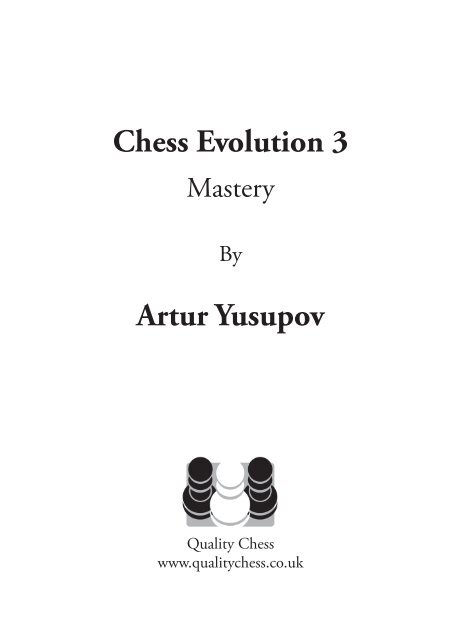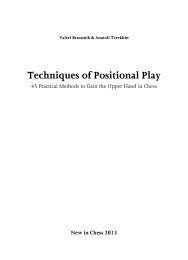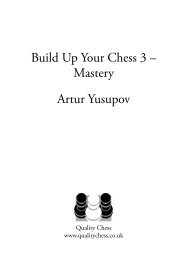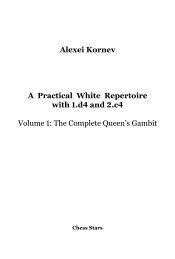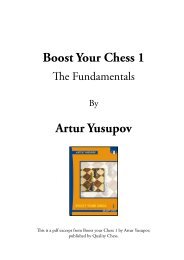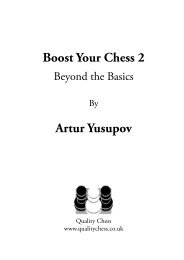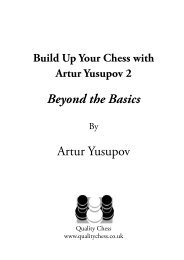Create successful ePaper yourself
Turn your PDF publications into a flip-book with our unique Google optimized e-Paper software.
The comparison method1...¦f1†Here after 1...¦g2 2.¦xe3† ¢h4 (2...¢xh2 leads tothe draw we have already seen: 3.¢g5 g3 4.¢h4!=),White has the saving grace: 3.¦e4! ¦f2† 4.¦f4 Nowwe see the advantage of choosing the f5-square forthe king on the first move. 4...¦f3 5.¢e4=2.¢g52.¢e4? would lose to 2...¦f2.2...¦f3 3.¦e1!Not 3.¦a2? ¦f2 4.¦a3 ¦xh2 5.¦xe3† g3–+.3...g3If 3...¢xh2, then 4.¢xg4 ¢g2 5.¦e2†=.3...¢g2 is followed by: 4.¢xg4 ¢f2 5.¦a1 e2 6.h4¦g3† 7.¢f5 e1£ (or 7...¦h3 8.¢g5 ¦a3 9.¦b1 e1£10.¦xe1 ¢xe1 11.h5=) 8.¦xe1 ¢xe1 9.h5=4.hxg3 ¢xg3 5.¦e2 ¢h3 6.¦a2 ¦f2 7.¦a3 ¦f38.¦a2 ¢g3 9.¦e2=chapter 3Diagram 3-3Z.Azmaiparashvili – A.<strong>Yusupov</strong>Las Palmas 1993I had calculated the variation 22...¤xe3 23.fxe3 ¦xb224.¤c4 £h4 and seen that a draw would result. Butwhich move order is correct – first 22...¤xe3, andonly then 23...¦xb2, or vice versa? I saw that after22...¦xb2 23.¤c4 ¤xe3 White might play 24.¦xe3,and decided to avoid that variation. Unfortunately Ioverrated the first move order and did not spot theimportant opportunity that it allowed my opponent.22...¤xe3?The correct way was: 22...¦xb2! 23.¤c4 ¤xe324.fxe3 (After 24.¦xe3 Black has a simple solution:24...¦b6 25.¤xb6 axb6ƒ with sufficient compensationfor the exchange.) 24...£h4 25.¤xb2 £g3† 26.¢h1¤xh3= 27.¥xh3 £xh3† 28.¢g1 £g3† 29.¢f1 £h3†White cannot avoid perpetual check without taking arisk. 30.¢f2?! £h2† 31.¢f3? ¦e8! 32.e4 ¥c5–+23.fxe3 ¦xb2 24.¤e4!I had simply overlooked this active move!As we have seen, 24.¤c4 £h4= achieves nothing.Diagram 3-4The knight now protects several important squareson the kingside. Black wants to attack at any cost, butWhite has enough resources for a successful defence.35Diagram 3-3q Diagram 3-4q
chapter 3Diagram 3-5r Diagram 3-6r Calculating variations 124...¤xh3†24...£h4?! 25.exf4 f5 can be met by: 26.£d5†¢h7 (26...¢h8 27.£xd6+–) 27.¦e2 ¦xe2 28.¤g5†¢h6 29.¥xe2±24...¥c7!? was possible, and Black obtains a certainamount of compensation for the piece, though notreally enough. For example, 25.£xd8 ¦xd8 26.exf4and now either 26...exf4± or 26...¥b6† 27.¢h1 f528.¤g5 ¦dd2 29.¤f3 ¦f2 30.¥c4† ¢f8 31.¦f1±.25.¥xh3 £h4Diagram 3-526.£f3!±White consolidates his position. Black has only twopawns for the piece, and his final attempt at an attackwill be refuted.26.£c1? is bad on account of 26...¦fb8!–+, but not26...£xh3? 27.£xb2 £xg4† 28.£g2+–.White could also play: 26.¥g2 f5?! (26...¥c7±)27.£d5† (but not 27.£xd6? fxe4‚) 27...¦f728.¦f1!+–26...f5?!26...¥xa3 would be an improvement, thoughWhite is better after either 27.¦f1± or 27.¦eb1±.27.gxf5 gxf527...¥e7 28.¦eb1+–28.¤xd6 e4Diagram 3-629.¤xe4!White returns one of the pieces, but forces theexchange of queens.29...fxe4 30.¥e6† ¢h7 31.£h3!+– £xh3 32.¥xh3¦f332...¦f6 is more resilient: 33.¦ab1 ¦a2 34.¦b5¦g6† 35.¢f1 ¦f6† 36.¦f5 ¢g6 37.¦xf6† ¢xf638.¥g2+–33.¥f1 ¦g3† 34.¢h1 ¦b334...¦b6 is met by 35.¦a2+–.35.¥g2White has a decisive advantage in material.35...¢h6 36.¥xe4 ¦gxe3 37.¦xe3 ¦xe3 38.¥c6¦c3 39.¥b5 ¢g5 40.a4 ¦c7 41.¦d1!Threatening ¦d7.41...¦c8 42.¦d7 ¦a8 43.¦xg7† ¢f5 44.¥c6 ¦h8†45.¢g2 ¦h6 46.¥b5 a6 47.¥d3†1–036
Ex. 3-1 ««« q Exercises Ex. 3-4 «« qchapter 3Ex. 3-2 «« r Ex. 3-3 «««« r Ex. 3-5 ««« r Ex. 3-6 ««« r 37
chapter 3Ex. 3-7 «« r ExercisesEx. 3-10 «« r Ex. 3-8 ««« r Ex. 3-9 «« r Ex. 3-11 ««« r Ex. 3-12 ««« r 38
Ex. 3-1J.Bradford – R.ByrneUSA Ch, Greenville 1980The game continued:30...£d4?? 31.£xh7† ¢xh7 32.¤xf8†+–(1 point for this variation)32...¢g8 33.¦xd4 ¤bc2 34.¦xe41–030...£f5 (1 point) is a better move. After31.¤xf8 ¤xd1 32.£xh7† £xh7 33.¤xh7 ¤c234.¤g5µ White still has drawing chances.However, the correct move is: 30...£d6!–+.(2 points)Black protects the rook on f8 and wins easilyin all variations. For example 31.¦e1 £d2 or31.¦b1 £d4–+.Ex. 3-2V.Smyslov – V.MikenasUSSR Ch, Moscow 194927.¥e3!=(2 points)Other bishop moves are no good:a) 27.¥g5? £g7 28.£h5† ¢g8–+b) 27.¥f8? £e4 28.£h6† £h7–+The move in the game leads to a perpetualcheck: 27...£xe3 (27...¥xe3? 28.¦f7+–)28.£h5† ¢g8 (28...¢g7? 29.¦f7†+–)29.£f7†=½–½Ex. 3-3E.Kolesnikov19891.¦f8!!(1 point)1.¢f7? achieves nothing on account of:1...¢xd4!(1 point for this variation)2.¦f6 (2.¢e6 ¢e3 3.¦f5 d4 4.¦e5† ¢f25.¦d5 ¢e3=) 2...¢e3 3.¦e6† ¢f3 4.¦d6 ¢e45.¢e6 d4=Solutions391...¢xd4 2.¢f7 ¢e4 3.¦e8†!(another 1 point)3...¢f3 4.¦d8A standard idea of checking to gain atempo.4...¢e4 5.¢e6 d4 6.¢d6!(another 1 point)A typical flanking manoeuvre.6...d3 7.¢c5 ¢e3 8.¢c4 d2 9.¢c3+–Ex. 3-4Variation from the gameV.Nedeljkovic – T.ZatulovskayaSplit Olympiad 196360...¢f4!!(1 point)60...¢xf3? is bad: 61.¢xe5 ¢g3 62.¢f5!¢xh3 63.e5 ¢g3 64.e6 h3 65.e7 h2 66.e8£h1£ 67.£e3† ¢h2 68.£e5†!+–61.¢g661.¢e6 ¢g3 62.¢xe5 ¢xh3 63.¢f5 (63.f4¢xg4=) 63...¢g3 64.e5 h3 65.e6 h2=(another 1 point for this variation)61...¢xf3 62.¢f5Or 62.¢xg5 ¢xe4 63.¢f6 ¢d4 64.g5 e4=.62...¢g3 63.¢xg5 ¢xh3 64.¢f5 ¢g365.g5 h3 66.g6 h2 67.g7 h1£ 68.g8£† ¢f369.£b3† ¢e2 70.¢xe5 £h8†=Ex. 3-5End of a study byV.Khortov19624.¦d4!!(2 points)4.¦d7? loses because of the following line:4...¢c2 5.¦c7† ¢b3 6.¦d7 ¢c4 7.¦c7† ¢b58.¦b7† ¢c6 9.¦b1 a2–+4...¢c3 5.¦a4 ¢b3 6.¦d4 ¢c2 7.¦c4†(another 1 point)7...¢b2 8.¦b4† ¢c3 9.¦a4=½–½chapter 3
Ex. 3-11G.Nadareishvili1960SolutionsEx. 3-12G.Nadareishvili1961chapter 31.c7!(1 point)1.d7 is wrong: 1...¦xd7! 2.cxd7 c3 3.d8£c2=1...¦a8 2.d7 c3 3.c8£(another 1 point)3.d8£? ¦xd8 4.cxd8£ c2=3...¦xc8 4.dxc8¦!(another 1 point)This is simplest, although 4.dxc8£ c2 5.¤f7!(also 1 point) is good enough too: 5...¢b1(5...¢b2 6.¤e5+–) 6.£f5 ¢a1 7.£f1† ¢b28.¤e5+–4...¢b2 5.¤f7 c2 6.¤e5+–The knight gets back in time.1.¦g5!(1 point)Other moves do not win:a) 1.¦xg7? ¢h2 2.¢b6 h3 3.¢c5 ¢h14.¢d4 h2=b) 1.¢b6? g5!(another 1 point for this variation)2.¢c5 ¢h2 3.¦a1 (3.¦xg5 h3 4.¢d4 ¢h15.¢e3 h2=) 3...g4 4.¢d4 g3 5.¢e3 g2 6.¢f2h3 7.¦d1 g1£† 8.¦xg1=c) 1.¦g6? ¢h2 2.¢b6 h3 3.¢c5 ¢h14.¢d4 h2 5.¦g3 g5 6.¢e3 g4=1...¢h2 2.¢b6 h3 3.¢c5 ¢h1 4.¢d4 h25.¢e3 g6 6.¦g3! g5 7.¢f2 g4 8.¦a3 g3†9.¢xg3 ¢g1 10.¦a1#(another 1 point)ScoringMaximum number of points is 3227 points and above Excellent22 points and above Good16 points Pass markIf you scored less than 16 points, we recommend that you read thechapter again and repeat the exercises which you got wrong.41


